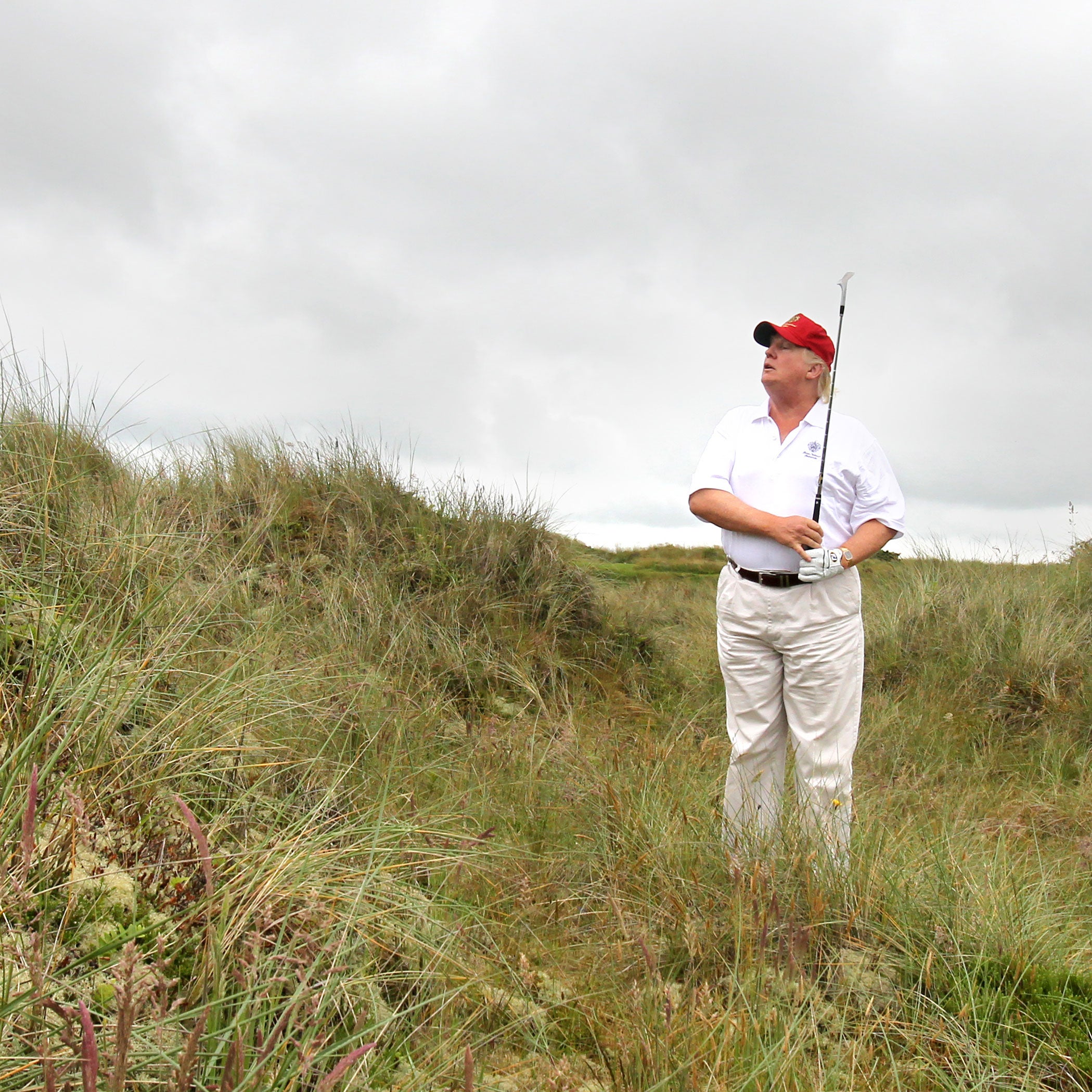As a candidate, Trump frequently contradicted himself on environmental and public-lands policy��(as ���ϳԹ��� found out when trying to pin down his positions before the election). But we’re getting some glimpses of what a Trump Administration might do. And many who care about the environment are deeply worried.
“I think you have the possibility of the most important and, from an environmental point of view, disastrous impacts, in the last 40 years,” says��Don Barry, a former assistant Secretary of the Interior for Fish, Wildlife and Parks and former chief counsel for the U.S. Fish and Wildlife Service. Barry also worked as an executive the Wilderness Society and World Wildlife Fund.
“It’s not just Trump by himself, it’s Trump and the environmental control of Congress…that makes this so deadly.”
Here are some potential Trump policies ���ϳԹ��� was able to divine.��
He Could��Open Public Lands to More Energy Extraction ��
Trump spoke repeatedly during the campaign about wanting more exploratory drilling on federal land. The incoming administration’s ��emphasizes opening onshore and offshore energy leasing on federal lands and waters, as well as rescinding the coal mining lease moratorium on federal lands.
“It’s all upside: more jobs, more revenues, more wealth, higher wages, and lower energy prices,” the site declares.
These priorities worry Athan Manuel, director of the lands-protection program for the Sierra Club.
“You can’t overstate how abrupt this change is going to be,” says Manuel. Earlier this year, the Obama Administration canceled plans to open millions of acres off the East Coast to drilling after outcry from beachfront communities and environmentalists. The administration tightened rules on drilling in Arctic waters, and also ordered the moratorium on all new coal leases on public lands.
Now, “you’ll probably see efforts to try to drill in the Arctic Ocean, onshore in the Arctic National Wildlife Refuge (ANWR), and probably some expanded moves to drill offshore in the lower 48,” says Manuel. Possible locations include off the west coast of Florida, in the eastern Gulf of Mexico.
There’s a silver lining: new drilling and other changes won’t simply start in such places on January 21. Despite the incoming administration’s promise to “streamline the permitting process for energy projects” and the aid of a Republican-controlled Congress, new regulations take time.
Offshore drilling, for instance, is planned in five-year increments. A draft of the 2017-2022 plan—which is not expected to include drilling in the aforementioned locations —is set to be released by year’s end, says Manuel. Changing the regulations would take a new administration a few years. “It’s hard to get stuff done in Washington,” he says, citing Democrats’ success in filibustering efforts under George W. Bush to open ANWR to drilling more than decade ago.
On the Obama Administration’s coal moratorium, the incoming Secretary of the Interior can undo that “with the stroke of a pen,” says Jeremy Nichols, climate and energy director for WildEarth Guardians. “It can be done, and it can be undone,” Nichols said of the moratorium. “And we would have no legal recourse.”
Coal opponents like Nichols’ group now will fall back on the tactics that helped secure the moratorium, he said, including filing lawsuits and confronting lease decisions.
It's not clear that lifting the moratorium will revive a moribund industry, however. Trump has also touted natural gas (fracking), which directly competes with the former. Both can’t prosper. “The industry is winded. The long term prognosis is not good.” Still, the changes give the industry the chance to survive a bit longer, which isn’t good for the planet, Nichols says. “The coal industry needs to go out of business, now.”��
He Could Mollify Those Angry About Federal Land Ownership
The election of Trump could cool the argument over who owns the West’s federal lands that, at its worst, has resulted in events like the Patriot takeover of Oregon’s Malheur National Wildlife Refuge, says Michael Blumm, a professor at Lewis & Clark Law School.
“If the past is any indication of what we can expect, when we did elect a Sagebrush Rebel [Ronald Reagan]��to the presidency in 1980, the Sagebrush Rebellion largely subsided,” says Blumm. The presidency of Bill Clinton, and subsequent grazing reforms under his Secretary of Interior Bruce Babbitt, “engendered another rebellion.”
While many Western state legislatures have been clamoring for the feds to hand public lands over to the states, Trump said on several occasions he’d prefer not to do so. Yet Trump’s election could still mollify these extremist groups, says Blumm. A president who keeps federal lands under the purview of the federal government��but who loosens restrictions for grazing or energy exploration “won’t seem oppressive anymore.”
That doesn’t mean the land couldn’t be dramatically altered, even if it’s still under federal ownership. “The outdoor recreation industry is going to be the one paying the price for this,” says Barry, the former assistant Secretary of the Interior. “Forget trying to go camp or fish on it.”
He Could Appoint a Very Divisive Secretary of Interior��
On Sunday, the New York Times reported that the short list of those being considered for Secretary of the Interior includes: Forrest Lucas, president of Lucas Oil Products; Sarah Palin, the former governor of Alaska; Jan Brewer, the former Arizona governor; and Harold G. Hamm, a fracking magnate and founder of the energy company Continental Resources.
The Department of Interior oversees America’s public lands, natural resources, wildlife, and relationship with its native peoples.
“What can the Secretary of the Interior do? A lot,” says Barry. He or she sets the tone, the agenda, and the priorities for the department. As much as anything, though, that chair “affects the budgets, and budgets drive policy in this city.” In other words, the Secretary of the Interior can lavish money on some of the department’s agencies and allow others to starve.
Take this example. A few years ago, Barry says, ��then-chairman of the House Budget Committee (and now Speaker of the House) Paul��Ryan came out with a budget proposal that would have cut funding to the U.S. Fish and Wildlife Service by more than 20 percent. “That would devastate the refuge system.”Allies pushed back, however, and the cuts didn’t happen.
“During Reagan and ‘Bush II’ there were still moderate Republican senators on the Hill who supported conservation. Those Republicans are gone,” says Barry. “They were a counterbalance.” Now, he said, that wing has been pretty well disassembled.
Palin, who’s on Trump’s list for this job, in 2015 that she would love to head the Department of Energy. “Energy is my baby,” Palin said. “Oil and gas and minerals and those things that God has dumped on this part of the earth for our use instead of relying on other unfriendly nations.”
Palin said she wouldn’t keep the job for long, however. “If I were head of that, I’d get rid of it,” Palin said of the department. She would give the states more control over their energy policy.
The issues she mentioned, however, are overseen by the Department of the Interior, not the Department of Energy.��
He Could Defang the EPA ��
How an incoming administration will achieve energy and business goals while also protecting the environment is not clear. During the campaign Trump said he would gut the Environmental Protection Agency, saying it’s bloated and that it unnecessarily impedes commerce.
Trump took a big step in that direction��when he immediately tapped Myron Ebell, a well-known climate change denier, to oversee the transition at the EPA—a move that reminded some dismayed observers of Ronald Reagan’s appointment of James Watt to head the Department of Interior in the 1980s. Ebell is reportedly on Trump’s short-list to head the agency.
Some of the most concrete proposals so far have come in the form of rollbacks. The incoming administration has said that it will roll back the EPA’s Clean Water Rule. The rule, a major piece of Obama’s environmental agenda, was designed to bolster the federal government’s ability to ensure clean water in the nation’s lakes, wetlands, and waterways. The rule infuriated many in the business community.
“The Trump Administration is firmly committed to conserving our wonderful natural resources and beautiful natural habitats,” the incoming administration’s website reads. “America’s environmental agenda will be guided by true specialists in conservation, not those with radical political agendas.” ��
Efforts to Mitigate Climate Change Could Go Out the Window�� ��
Candidate Trump has called the phenomenon a “hoax,” and he has said he would renege on the U.S.’s voluntary pledges to reduce emissions under the Paris Climate Agreement. “There are certainly ways to withdraw from the Paris agreement,” says Rachel Cleetus, lead economist and climate policy manager at the Union of Concerned Scientists.
The accord’s goal is to phase out greenhouse gas emissions with a shift from fossil fuels. Any country wanting to pull out after joining up has to wait four years, according to the treaty’s Article 28, Reuters reported. But Trump could use “legal short-cuts” to disentangle from the treaty in as little as one year, lawyers told the news agency this month.
“Our hope is that President-Elect Trump will take a look at what’s at stake and reach a decision that is to the benefit of all Americans,” says Cleetus.��Even China, the world’s largest greenhouse-gas emitter, last week warned Trump not to abandon his country’s climate obligations.
The shift to renewable energy “is already underway” and will continue strongly, and the work by nations is continuing in Morocco, the site of the 2016 U.N. Climate Change Conference, says Cleetus.
According to an by Lux Research, based on Mr. Trump’s policy proposals, U.S. carbon emissions after two terms of a Trump Administration would be 16 percent higher than after two terms of a Hillary Clinton administration. That amounts to 3.4 billion more tons over the next eight years. ��
He Could Green-Light Keystone XL ��
During the campaign, Trump had said that in his first 100 days in office he would encourage the Canadian company TransCanada to re-apply for permission to build the Keystone XL pipeline. Many environmentalists have feared that the pipeline would be disastrous, both symbolically and otherwise, for the nation’s ongoing dependence on fossil fuels.��
Both industry and environmental groups an incoming Trump administration—with its emphasis on domestic energy production as well as improving the nation’s infrastructure—is likely to result in more proposals for oil and gas pipelines and more battles over those same proposals.
He Probably Won’t Overturn National Monuments ��
President Obama protected more acreage—land and water—than any other U.S. president. “Hopefully the (incoming) president won’t go after the monuments that the president designated,” says Sierra Club’s Manuel.��He likely won’t. It’s hard to overturn a monument, unless Congress gets involved. And while there are no guarantees it won’t, Manuel knows of only a few small, minor cases where this happened. “In hindsight, people like a lot of these proposals.” ��


